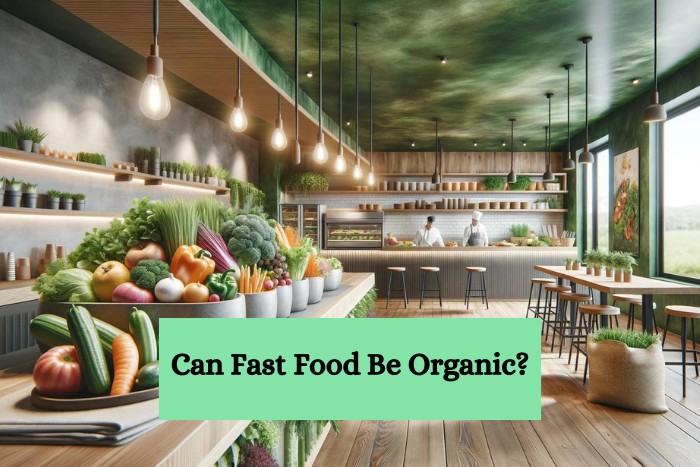‘Organic’ in food means products grown and processed without synthetic fertilizers, pesticides, GMOs, or ionizing radiation. The USDA certifies organic foods in the US, ensuring strict standards are met. Fast food chains now offer organic options due to rising consumer demand for healthier choices.
- Definition of Organic: Organic food must be grown and processed without synthetic chemicals, GMOs, or ionizing radiation. For example, organic apples at your local supermarket are produced without harmful pesticides.
- USDA Standards: In the U.S., the USDA enforces strict standards for organic certification, covering everything from soil quality to pest control. Think of USDA-certified organic milk, which guarantees no synthetic hormones or antibiotics.
- Challenges for Fast Food: Integrating organic ingredients into fast food is challenging due to higher costs and the need for consistency. McDonald’s offering organic milk in some locations highlights this shift toward healthier options.
- Consumer Demand: Rising consumer interest in health and sustainability drives fast-food chains to include organic items. Starbucks’ organic coffee options cater to this growing preference for environmentally friendly products.
- Technological Advancements: Innovations like vertical farming and precision agriculture help make organic fast food more viable and affordable. Chipotle’s commitment to using organic ingredients exemplifies how technology supports scalable organic farming practices.
The word ‘organic’ might conjure images of fresh farmers’ markets or boutique health food stores more often than it reminds us of the drive-through. But what exactly does ‘organic’ mean?
Regarding food, ‘organic’ signifies products that are grown and processed without synthetic fertilizers, pesticides, genetically modified organisms (GMOs), or ionizing radiation. It’s a label that stands for a commitment to certain environmental and health standards.
For food to be marketed as organic in the United States, it must meet strict government standards. These standards are overseen by the United States Department of Agriculture (USDA) and cover every step of production, from soil quality and pest control to animal-rearing practices.
🌿 Benefits of Organic Fast Food 🌿 |
|
|---|---|
| ❤️ Healthier Choices | Organic fast food reduces exposure to synthetic chemicals and additives, promoting better overall health. |
| 🌍 Environmental Impact | Organic farming practices help preserve local ecosystems by reducing chemical runoff and enhancing soil quality. |
| 🚜 Sustainable Farming | Supporting organic fast food encourages sustainable farming practices and fair wages for farmers. |
| 💰 Economic Benefits | Although organic options may cost more initially, they contribute to long-term environmental sustainability and health savings. |
| Brought to You by athomewithtai.com | |
The certification is a rigorous process, ensuring consumers receive genuinely organic products. However, integrating organic ingredients into fast food presents unique challenges.
Fast food thrives on consistency, speed, and typically, low costs. Organic products, which are often more expensive due to higher production costs, might disrupt this model.
However, some fast food brands are stepping up to the plate, seeking out ways to incorporate organic items into their menus while keeping meals affordable and convenient. Consumer interest in healthier dining options has steadily climbed, influencing even the most recognizable fast-food chains to consider organic options.
For instance, certain multinational chains now offer organic milk or coffee as part of their menu. It’s a significant nod to the shift in consumer preferences and an acknowledgment of the increasing importance of organic foods in the industry.
I will next look into whether such a model can achieve the delicate balance between staying true to the quick service ethos without compromising on the ethical and health aspects of organic offerings. One can’t ignore the wider implications this trend poses for not only our diets but also for organic farmers and the planet as a whole.
The Feasibility and Future of Organic Fast Food

The shift to organic fast food isn’t just a fleeting trend; it’s becoming a critical aspect of the industry’s evolution. Cost and accessibility remain the greatest hurdles as customers typically associate organic with expensive.
But is this always the case? Let me dissect the cost structure of organic fast food, comparing it to traditional offerings and revealing where the extra pennies go.
Often, the increased costs reflect fair wages for farmers and higher-quality ingredients. Organic farming practices are also seen as investments towards environmental sustainability, which can eventually lead to reduced expenses in the long term.
The positive effects of organic fast food go beyond personal health. Environmentally, these dedicated farming methods reduce chemical runoff and preserve local ecosystems, aligning with the larger global movement toward environmental consciousness.
So, I can see the promising partnerships cropping up between organic farmers and fast-food chains, creating a support network that benefits the farm-to-table pipeline and the wider community. Key technological advancements are also playing their part, enhancing the scalability of organic produce. Innovations like vertical farming and precision agriculture are crucial.

They improve yield and quality, reduce waste, and make organic fast food more viable than ever before. Let me share some insights on how these technologies are changing the game and potentially lowering costs.
With all eyes on the future, it’s essential to gauge where we’re headed. Market trends suggest a growing appetite for organic options in fast food, with more consumers prioritizing sustainability and health.
In response, the industry is adapting, with new and old players alike expanding their organic selections. I have seen industry projections and consumer behavior studies that indicate a clear path toward increased organic offerings in fast-food outlets.
My Final Thoughts
Looking ahead, the trajectory for organic fast food is upward, with challenges turning into opportunities for innovation, health, and environmental stewardship. Remember that every organic meal chosen at a fast food restaurant is a step towards a healthier self and planet.
By supporting this shift, consumers can help bring about a future where fast, affordable food also means quality and sustainability. How do you think the increasing availability of organic options in fast food will impact your dining choices and overall lifestyle?
Let me know in the comments below!
FAQ

1. What does ‘organic’ mean in food?
- ‘Organic’ refers to food grown and processed without synthetic fertilizers, pesticides, GMOs, or ionizing radiation.
- It means the product has met strict USDA standards for environmental and health safety.
2. How is organic food certified in the U.S.?
- The USDA certifies organic food, ensuring it meets rigorous standards for soil quality, pest control, and animal-rearing practices.
- Organic certification involves a thorough review of farming processes and regular inspections to maintain compliance.
3. Why is organic food more expensive?
- Organic food often costs more due to higher production expenses, such as labor-intensive farming practices and smaller-scale operations.
- The higher price also reflects fair wages for farmers and investment in sustainable farming methods.
4. Can fast food be organic?
- Yes, some fast food chains are incorporating organic ingredients into their menus, like organic milk and coffee at McDonald’s and Starbucks.
- Although challenging due to cost and consistency issues, the fast-food industry is responding to consumer demand for healthier options.
5. What are the benefits of eating organic fast food?
- Eating organic fast food reduces exposure to synthetic chemicals and supports environmentally friendly farming practices.
- It aligns with a growing preference for healthier, more sustainable dining options, contributing to better personal health and environmental stewardship.
6. How can organic farming technologies lower costs?
- Technologies like vertical farming and precision agriculture improve yield and efficiency, making organic produce more affordable.
- These advancements help scale up organic farming, reducing waste and production costs while maintaining quality.

I’m Diane, a culinary enthusiast who loves to share my cooking adventures and knowledge with you.
This blog is my cozy corner on the internet where I unravel the secrets behind making everyday cooking simple, enjoyable, and downright delicious.
Whether it’s unlocking the flavor potential in chicken or figuring out why your mashed potato cakes won’t hold together, I’m here to guide you through.
Join me as we explore various dishes, solve common kitchen dilemmas, and discover new recipes that will make you fall in love with cooking all over again.
Cooking is an adventure that’s best shared, so let’s get started!

